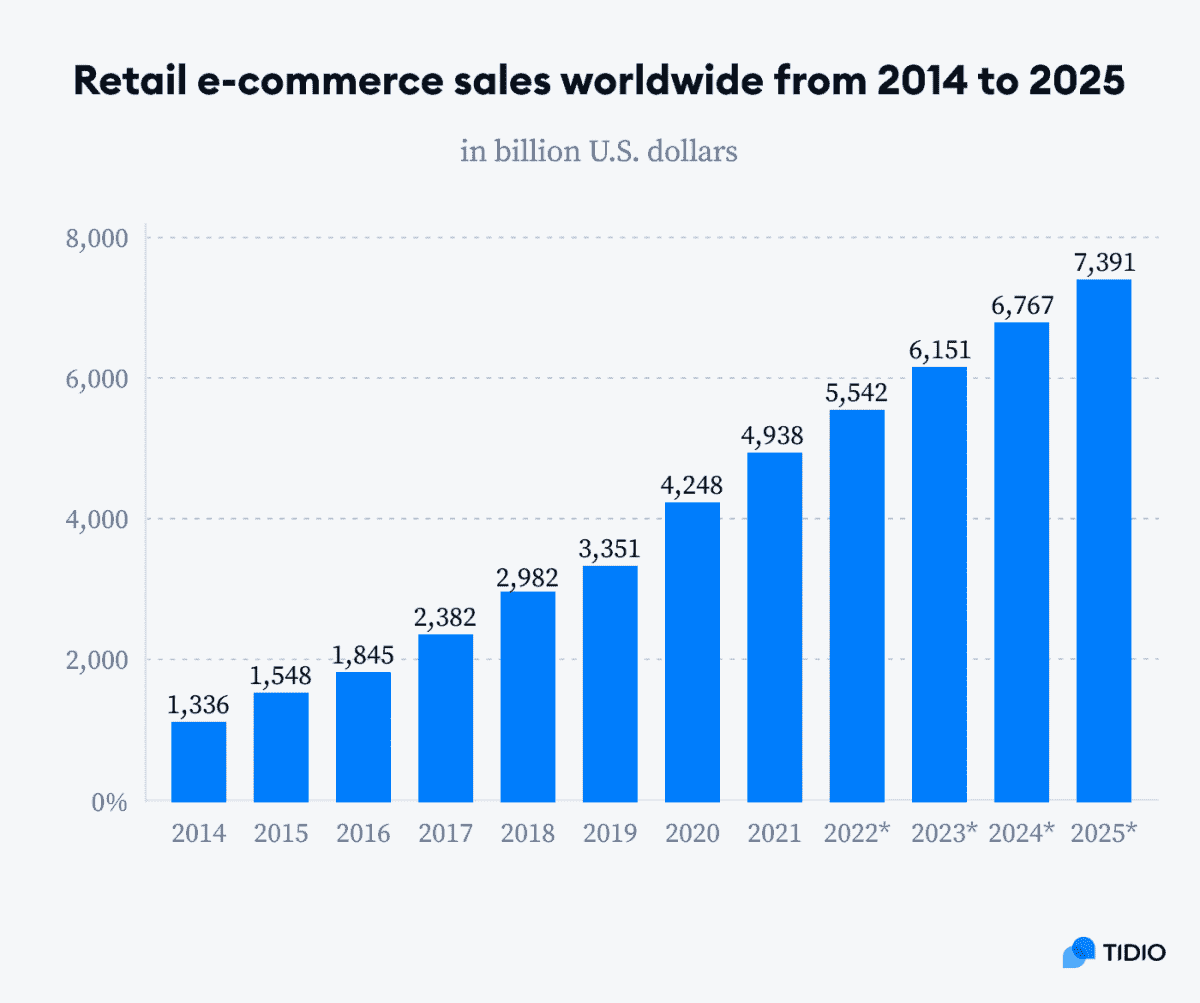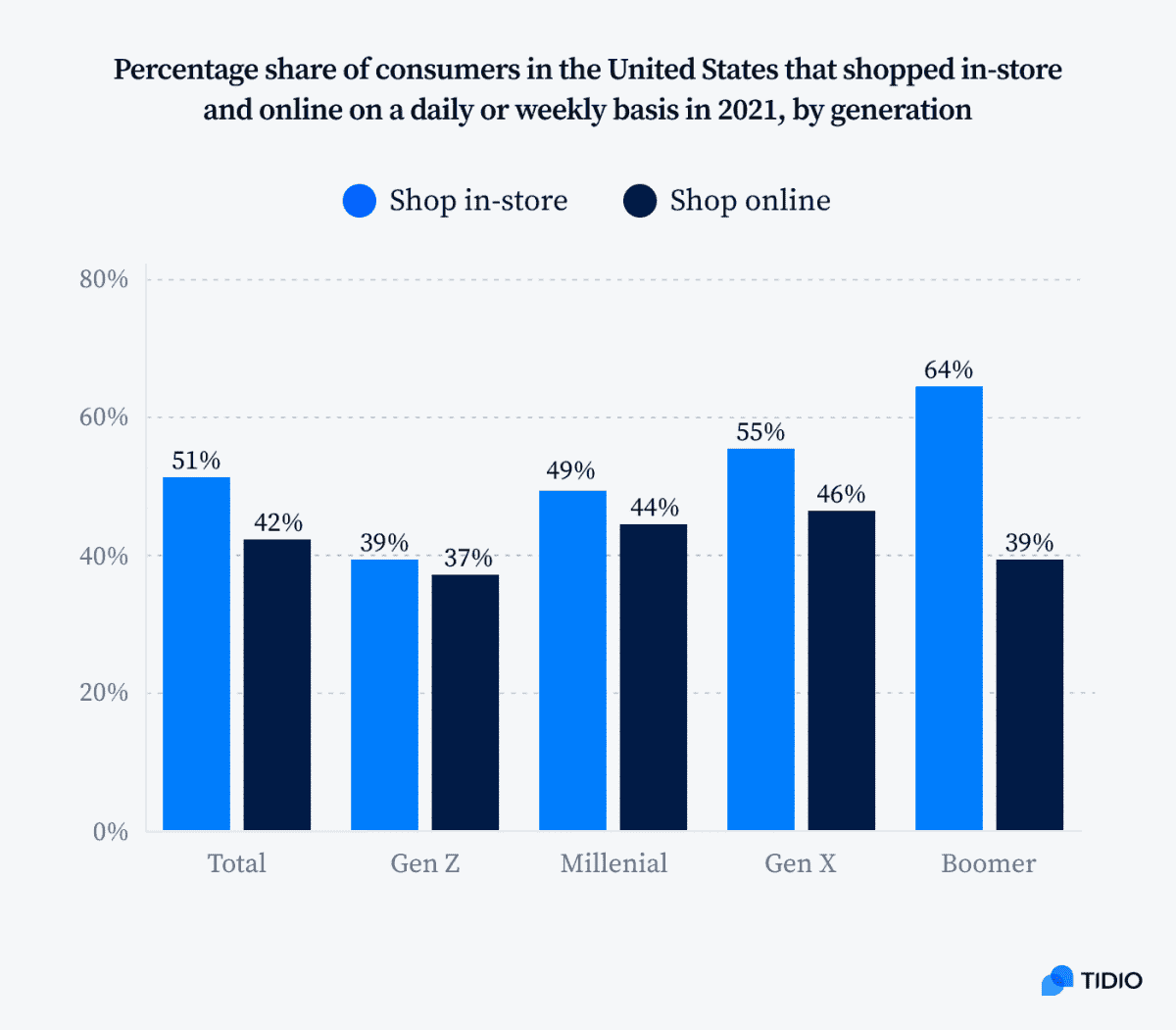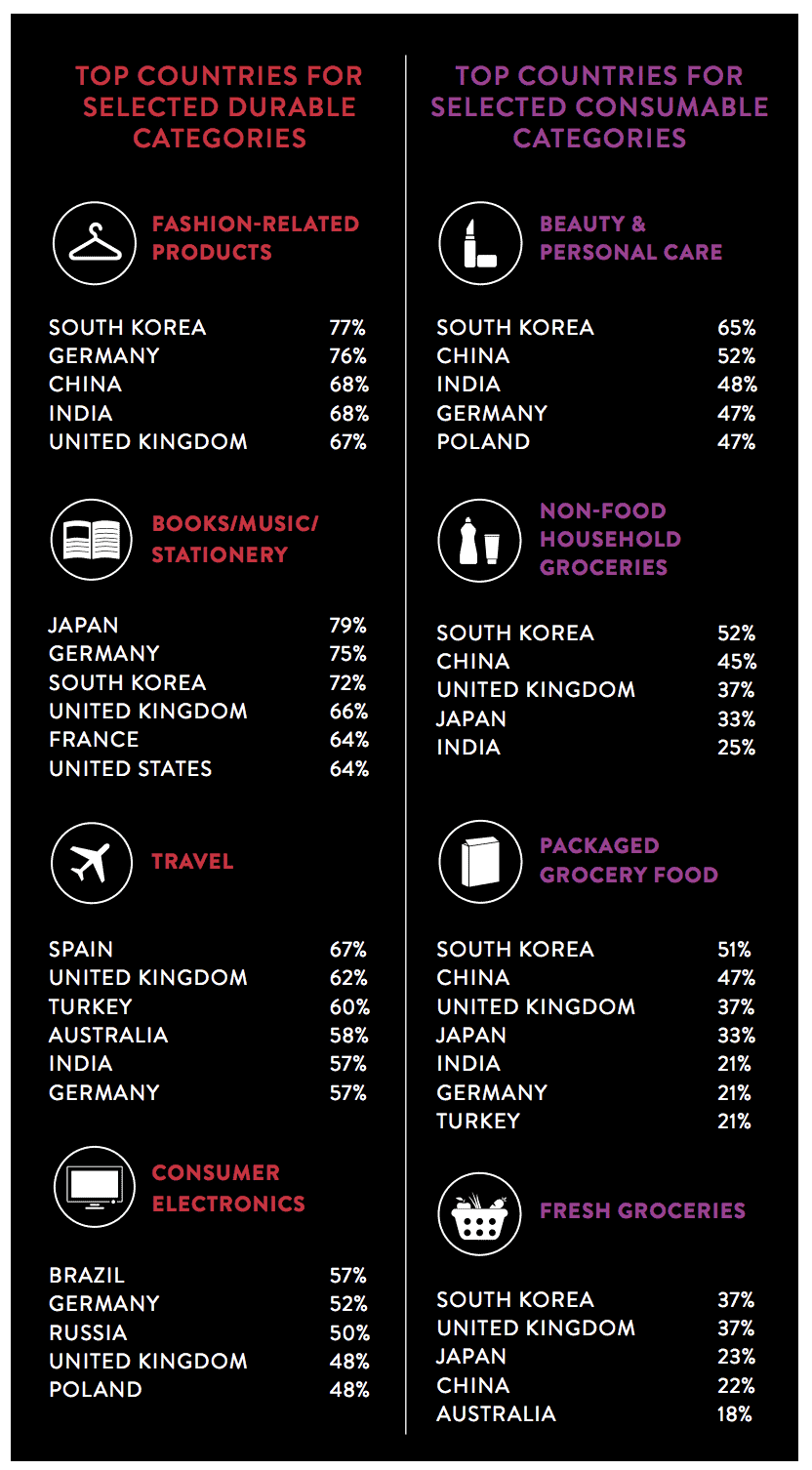The emergence of eCommerce platforms has positively impacted almost all businesses.
The driving factor for their mind-blowing growth is the comfort they provide consumers. Even for sellers, it helps them reduce their operating costs, leverage a great deal of data on consumer behavior, and stay ahead of the competition by using the internet and mobile power.
With the surge in the use of mobile phones, the internet, and social media platforms, it has become competitively advantageous for businesses to move to eCommerce.
In this blog post, we will discover interesting online shopping trends and statistics that might help you as a business beat your competition and cater to the ever-growing and changing demands of consumers.
Let’s get started!
Table of Contents
Key Takeaways
- As of 2024, eCommerce sales will likely pass $7 million in value.
- Currently, there are between 12 and 24 million online retailers globally.
- Almost 20% of retail sales happen online.
- The annual growth rate for in-store sales is about 4%, while for eCommerce sales, it’s almost 13%.
- 74% of consumers depend on social media platforms to make purchasing decisions.
- In Covid-19, 3% of Americans started shopping online and bought something online for the first time.
The Rise of eCommerce: Online Shopping Statistics
eCommerce is changing the retail industry. Consumers’ shopping habits and behavior are rapidly changing, making buying things from the Internet a new normal.
But, businesses are questioning and struggling to adapt to the ever-changing and fluctuating online shopping trends. They are constantly looking for data and statistics to build a robust eCommerce business.
It is believed that in 2024, global eCommerce sales will likely surpass $7 trillion in value. This crazy growth is a result of multiple factors, such as:
- Rise of mobile shopping
- Growth of social media influence
- Popularity of subscription services
- Deeper penetration of the internet
- Better shipping services
Currently, the Asia-Pacific and South American regions are witnessing the fastest growth in the eCommerce sector.
This is because of the dynamic adoption of newer technologies and, most importantly, these countries’ younger demographic structure. Naturally, the newer generation is more tech-savvy and prefers shopping online.
The United States market has matured, as it has been using eCommerce solutions for years. However, it is still worth noting that the US is still one of the top 10 fastest-growing countries when it comes to contributing to online retail sales. Almost 70% of Americans shop online.
In 2022, it was recorded that there were 268 million digital buyers in the US, and it is estimated that by 2025, this number will reach 285 million.
Some interesting numbers on eCommerce
- At present, 20% of all retail sales happen online.
- Over 2.3 billion consumers in 2022 made at least one online purchase.
- In the last 5 years, online shoppers have increased by 40%.
- During the same time period, online sales volume has increased by 218%
- Amazon, Walmart, eBay, and AliExpress are top eCommerce sites in terms of visitor traffic.

The crazy growth of the eCommerce sector has impacted physical stores and forced almost every business in the industry to have an online presence.
This has enabled them to cater to a wider market. For small businesses, going online has allowed them to carve out a niche for themselves and make their presence known through strong digital marketing.
Read More: Ikea Marketing Strategy — A-Z Analysis of the Winning Formula
Behavior and Preferences of Online Shoppers
Consumer behavior is ever-changing, and that too at a lightning-fast pace.
With the surge in technology and the 5G internet rolling out, digital disruption is changing how buyers purchase products and engage with brands.
This is causing brands to try and find ways to beat their competition and win over consumer expectations and demands.
The digital marketplace is becoming increasingly competitive, with process and product becoming secondary and the way brands make the consumer feel and experience coming first.
In today’s world, consumers are more demanding than ever. They want to define their experience, communicate through their preferred channel, and expect solutions and answers to their inquiries in the shortest amount of time.

Here are some stats that shed light on customer behavior regarding their online purchases:
- 87% of shoppers turn to the internet to research or shop for a product or service.
- Now, 82% of consumers want an immediate response to their questions and inquiries before purchasing. This has caused brands or businesses to invest in AI-enabled chatbots and automated messaging.
- 59% of shoppers have higher customer service expectations than a year ago. Consumers now prioritize brands that recognize their needs and offer top-notch interaction capabilities. Price and product have become second to customer experience.
- 32% of social media users expect brands to answer their questions within 30 minutes. The fast-paced nature of social media prompts brands to deliver a quick and consistent experience to consumers across all channels.
- 59% of consumers are using multiple channels to search for products and have their answers questioned. Social media platforms are essential for customer service for every group of people using a brand, not only millennials.
Read More: Dunkin Donuts Marketing Strategy — A Deep Dive
Digging into eCommerce Demographics
You would be interested to know that millennials and Gen Xers are the biggest online shoppers. 67% of millennials and 56% of Gen Xers prefer to shop digitally rather than going to physical stores.
This is because these population segments prefer to spend more time on their phones browsing multiple entertainment platforms.
Compared to older generations, millennials and Gen Xers spend 50% more time shopping online—six hours instead of four hours. Men outnumber women in online shopping statistics, spending 28% more than women, despite the stereotype that women are good shoppers.

How Technological Advancements are Shaping Online Sales
Advancements in technology accompany the rise of eCommerce, one of which is m-commerce or mobile commerce.
It is a subfield of eCommerce that refers to wireless devices used for commercial transactions such as online purchases, financial transactions, and other types of exchanges of products and services done over the Internet.
For example, if you shop for something from the Amazon app on your mobile phone, it’s m-commerce.
Mobile commerce is on a steady rise in the US. By 2025, mobile retail is expected to reach $710 billion, surpassing $430 billion in 2022.
Here are some of the top emerging trends and technologies of eCommerce.
Hyper-personalization
Taking personalization to the next level, we have hyper-personalization, which analyzes customer data by leveraging AI (Artificial Personalization) and deep learning.
This includes analyzing surfing patterns, purchase history, social media exchanges, and environmental and social data.
This results in each customer getting an extraordinarily advanced and personalized shopping experience. Hyper-personalization results in higher conversion rates and more customer loyalty.
This automatically translates into improving consumer experience and gaining a significant competitive advantage.
Artificial Intelligence (AI) and Machine Learning (ML)
Artificial intelligence uses a computer system to simulate human intelligence and perform tasks through automation that humans would otherwise perform.
Devices using AI can perceive the environment and collect and analyze data. This helps to optimize tasks and achieve goals faster. AI-powered platforms or systems can conduct environmental analysis, voice recognition, visual perception, and self-correction.
Machine learning is a vital subfield of AI and data science. It allows computers to learn how to carry out and optimize tasks, like making predictions regarding future outcomes, without being programmed for any specific scenarios in advance.
ML is used in fields like credit card fraud detection, which is common in eCommerce.
The combination of AI and ML will maximize sales by learning from user behavior in real-time, predicting intentions and preferences, and recommending relevant products in higher ranks.
Read also: Latest eCommerce Trends to Keep Track of in 2024
Seamless payments
Simplification and optimization of online payments have taken the eCommerce industry to greater heights.
By using passive authentication methods such as touch ID, QR-coded digital payment systems, UPI payment modes, and in-chat, which enable transitions, retailers can eliminate any difficulty in check-outs and amp up their sales.
Seamless payments through digital technology are making space for faster and more convenient shopping experiences. The main benefits of integrating a digital payment system are:
- Faster transaction speed
- Contactless payments
- Improved security for businesses and consumers
- Optimized user experience
Augmented Reality (AR) and Virtual Reality (VR)
Virtual Reality (VR) and Augmented Reality (AR) are rapidly becoming prominent trends in eCommerce technology.
They are revolutionizing how consumers interact with products and make decisions to purchase. This innovative technology reduces the gap between online and offline shopping by giving customers an engaging and genuine experience.
AR enhances the shopping experience by allowing shoppers to see the products in their surroundings by superimposing digital information over the actual world.
VR technology produces a simulated environment where shoppers can fully submerge themselves, offering a virtual retail experience.
The combination of AR and VR makes it possible for eCommerce platforms to offer:
- Online trials
- Interactive visual representation of goods
- Online Showroom
- Virtual encounters and events
Voice shopping
Convenience is the key factor driving the growth of the eCommerce sector.
This trend of voice shopping is adding convenience. Just imagine opening your fridge and feeling the need to shop for groceries. Traditionally, one would jot down the list with pen and paper and drive to the nearest grocery store.
But this is 2024, when groceries come to your doorstep. You do this by speaking to a virtual assistant like Alexa, who can say, “ Alexa, order bread, peanut butter, and jam.” Easy, right?
This has made multitasking much easier. You can speak directly to Google’s Alexa or Amazon’s Echo. Voice shopping reached $40 billion in 2022 and is expected to grow 3X in 2024.
Social commerce
The impact of social media cannot be ignored in any way. People are being influenced and making purchases every day from social media.
Social media platforms like Instagram and TikTok allow link sharing that prevents consumers from even leaving the platform. This integrated seamless purchasing option further adds to consumers’ convenience and sales. This phenomenon of influencing people to make purchases has allowed businesses to connect with active communities and establish loyal and long-lasting relationships with clients.
Interactive content creation, such as hauls, product demos, and live shopping experiences, is now essential for connecting with social media-addicted consumers.
Furthermore, retailers or brands hire in-house content creators to promote their products.
Read also: Discover the Best Online Business Ideas for 2025
Online Shopping Data by Region and Sector
More than 2.14 billion shoppers are now actively shopping online, which is no small number, considering the population is 7.9 billion. This means that 27% of people have converted to digital buyers.
It is common for everyone to consider the USA as the largest market for eCommerce, but surprisingly, it is not. Here is a list of the top ten largest eCommerce markets in the world:
- China: $672 billion
- USA: $340 billion
- United Kingdom: $99 billion
- Japan: $79 billion
- Germany: $73 billion
- France: $43 billion
- South Korea: $37 billion
- Canada: $30 billion
- Russia: $20 billion
- Brazil: $19 billion
The Global Connected Commerce Report by Nielsen sheds light on the most lucrative industries in the country.
- South Korea takes the lead in fashion (77%) and beauty products (66%).
- Japan is the leader in books, stationery, and music purchases.
- Spain tops the chart for travel with 67%.
- Brazil is the highest purchaser of consumer electronics at 57%.

The Impact of Social Media on eCommerce
It’s interesting to see and know that having a prominent social media presence can help brands establish a presence for themselves.
This is known as social commerce. It involves the shopping experience happening over social media platforms like Instagram, Twitter, Facebook, YouTube, or LinkedIn. Therefore, this means the products and services are marketed or promoted on these platforms.
Consumers can browse and shop on the platform itself.
Not only does it help them increase their sales, but it also gives them a better understanding of the latest trends and consumer behavior and helps them develop a brand identity and voice.
In fact, eCommerce stores with a prominent social media account or presence have 32% more sales than those without a social media presence.
Here are some of the ways social media affects the retail business digitally:
Increase in reach and visibility
Social media platforms are really places for users to browse new products. Social media allows businesses to reach a wider audience and increase their visibility.
The platform allows businesses to connect with their target audience and increase their visibility. With the help of social media, businesses can connect with their targeted audience and build a strong bond with them.
This relationship building is vital for having a loyal customer base and increasing sales for eCommerce.
Read More: 9 Foolproof Black Friday Marketing Strategies
Improved customer engagement
Social media platforms help businesses engage with their consumers in real-time.
The platforms allow customers to ask questions and provide product and service feedback. These platforms also allow businesses to showcase their brand personality, which helps retailers build trust and credibility with buyers.
Increase in sales
Social media sites are now an effective sales channel for companies.
Direct product purchases are now possible from social media networks. For instance, businesses can tag their products in their pictures on Instagram using the “Instagram Shopping” feature, making it simple for customers to purchase.
Additionally, social media sites give businesses the chance to make customized ads.
These ads are more successful at generating sales because they may be tailored to target particular interests and demographics.
Improvement in customer experience
Social media platforms offer businesses the chance to enhance their clients’ experiences.
Therefore, businesses can utilize social media, for instance, to offer product suggestions, customer service, and answers to customer inquiries. This support may make customers more receptive to you and your brand, encouraging repeat business and favorable evaluations.
Data and analytics
Social media networks give organizations access to insightful analytics and data.
This information can be used to measure the success of marketing initiatives, track customer behavior, and monitor engagement. Businesses need this information to make data-driven decisions and increase overall performance.
This shows how powerful a tool a social media platform can be for eCommerce. It allows businesses to sell their products and connect with the right audience in a lucrative manner.
Read also: How to Start an Online Business in 2025
Sustainable and Ethical Online Shopping Practices
The rise in eCommerce has sadly also led to increased pollution and a greater amount of waste, especially by brands that are into fast fashion and consumer goods.
This is having a really bad effect on the Earth. A study shows that 20% of products brought online are returned. Every year in the USA, 5 billion pounds of returned merchandise end up in landfills.
But the world is waking up now. Consumers are becoming more aware of their shopping habits. Recent reports state that 82% of shoppers want brands to adopt sustainable and people-first practices, and the new generation—Gen Z—is leading the change.
A survey found that three-quarters of Gen Zers consider sustainability more important than brand names.
Sustainable eCommerce practices include reducing waste, conserving resources, and minimizing carbon emissions.
Companies that promote sustainability are bound to gain a competitive edge in the market and become the preferred choice for savvy consumers.
Circular economy models
Circular economy models emphasize the reuse, recycling, and repurposing of products, extending the life cycle of a product and reducing wastage.
Implementing circular economy principles helps reduce environmental impact and promote resource efficiency. For eCommerce, this means offering products that can be easily recycled or repurposed, fostering a more sustainable consumption pattern.
Renewable energy integration
More and more eCommerce businesses are moving towards renewable energy resources like solar or wind power.
Using renewable energy allows eCommerce companies to minimize their dependency on fossil fuels, lower carbon emissions, and positively contribute to climate change. This transition will help brands enhance their reputation among environmentally conscious consumers.
Carbon neutral shipping
To achieve carbon-neutral shipping, greenhouse gas emissions from the transportation of goods are offset, usually by funding reforestation or renewable energy initiatives.
A company’s commitment to sustainability is demonstrated using carbon-neutral delivery methods, as shipping accounts for a significant portion of an eCommerce business’s carbon footprint.
It responds to customers’ mounting concerns about how their online purchases affect the environment and has the potential to be a significant differentiation in a crowded market.
Sustainable packaging
There is a noticeable tendency towards substituting recyclable or biodegradable materials with non-recyclable ones. Providing resources for environmentally friendly packaging. entails the use of recyclable, biodegradable, or recycled content components.
In addition to satisfying consumer desire for more environmentally friendly packaging options, sustainable packaging lowers the environmental impact of eCommerce products.
It’s a practical approach for companies to highlight their trash reduction and environmental initiatives.
Transparency and traceability
Customers’ growing demands for supply chain openness have sparked a trend in companies disclosing comprehensive details about the items’ sourcing, production, and distribution.
Organizations such as Fashion Revolution drive businesses to disclose more information about their product suppliers due to consumer demand for transparency in the supply chain.
Customers’ demand for ethical consumerism fuels this trend. After all, they want to make sure the goods they buy are made ethically and environmentally responsibly. Transparency and traceability strengthen consumer trust and loyalty and bolster a brand’s commitment to sustainability.
Read more: Omnichannel Customer Journey — A Beginner’s Guide
The Headache: Challenges in Online Shopping
The retail or eCommerce business also has its ups and downs, and it must confront challenges head-on, be it in adopting technology or retaining its consumers.
The ever-changing consumer behavior and data analysis are not easy, and crafting the experience they demand is one of the challenges.
Here is a list of challenges that eCommerce platforms go through:
Diminishing customer loyalty
The eCommerce and retail industry is experiencing a decline in brand loyalty because of fluctuating consumer behavior, influenced by social media and online content, which impacts the consumer’s shopping journey.
Furthermore, economic challenges worsen loyalty issues, as quick shipping expectations impact customer loyalty.
Performance related issues
High cart abandonment rates result from difficulties retailers confront, including complicated navigation, sluggish website loading times, and problems with checkout and payment methods.
Poor mobile experience
Retailers need to prioritize mobile responsiveness to address issues with clumsy user interfaces and slow-loading pages, as many purchases happen on mobile devices.
Hitting a growth wall
Due to low system performance and restricted scalability, retailers face scalability issues that increase the risk of outages and downtime during periods of heavy demand.
Selecting the right omnichannel experience
Retailers need help integrating different sales channels smoothly, leading to disparities in product catalogs, inventories, prices, and customer data.
Low ROI
Growing expenses for IT, upkeep, and development impede the effective implementation of solutions. Thus, cost-related issues must be addressed by optimizing financial results.
Read also: How to Start an Online Clothing Store in 2025
Case Studies on Successful Social Commerce Campaigns
In this section, let’s have some successful social commerce campaigns
Glossier
Glossier is a beauty brand building a robust community by encouraging its customers to share their experience with the products on social media.
By using hashtags like #glossierpink, Glossier can amplify customer engagement and authenticity, which is pivotal in growing its following and revenues.
Glossier’s strategy revolves around building a community through authentic interactions. The brand encourages users to post their pictures instead of a model’s and reviews using specific hashtags, which helps increase user engagement and trust.
This has resulted in Glossier amassing over 2.5 million followers on Instagram and generating substantial annual revenue. It has helped the brand develop a community-focused, authenticity-driven voice.
Fenty Beauty
Rihanna’s beauty brand, Fenty Beauty, leverages influencer collaboration to reach a broader audience, collaborating with influencers who share the brand’s values.
This strategy has successfully allowed Fenty Beauty to grow swiftly, surpassing $600 million in revenue in its first year. This has established the brand as a leader in inclusive beauty.
Fenty Beauty collaborations are designed to create buzz and drive inclusivity, a very important value for the brand. The brand successfully reaches its target audience by collaborating with influential beauty figures.
This strategy has resulted in the brand’s rapid growth, exponentially rising in the first year. But most importantly, it has set new beauty standards, normalizing inclusivity.
Read More: Mastering Brand Storytelling — Strategies and Examples
Conclusion
The online shopping fever is here to stay.
After considering all the stats mentioned throughout the blog, businesses need to prepare for the change in how consumers shop. Regardless of the industry sector, businesses must create an online presence that is user-friendly and engaging.
The prime reason eCommerce businesses and platforms are on the rise is that they can offer consumers great discounts, convenience, faster and easier transactions, and the experience they demand.
To provide customers with the shopping experience they need, businesses need to analyze heaps of data. For this, technologies like AI and ML are available now.
Frequently Asked Questions
What are the latest trends in online shopping for 2024?
The latest online purchase trends for 2024 mostly revolve around technological advancements and evolving consumer preferences.
Key trends we are witnessing are the use of virtual and augmented reality (VR/AR) to provide immersive shopping experiences to consumers and growth in social eCommerce with integrated shopping features.
There has also been a rise in AI and hyper-personalization of shopping experiences. Furthermore, voice shopping through Siri or Alexa is gaining a lot of attraction.
How much has online shopping increased in the past year?
Online purchases have been seeing significant growth. In 2023, the global eCommerce market surpassed $6 trillion, a 10% growth rate. The surge in mobile shopping powers Thai crazy growth, social media growth and usage, and growing demand for subscription services.
What percentage of shopping is done online vs. in-store?
As of 2023, 16.3% of all retail sales in the USA are online, up from 14.9% in 2022. This trend highlights the growing preference for online shopping over in-store shopping. While in-store shopping still holds a significant market share, online shopping is steadily increasing due to technological advancements and consumer behavior.
Which age group is shopping online the most?
Millennials (born between 1981 and 1996) are the most active online shoppers. Gen Z (born between 1997 and 2012) is a close second, preferring hybrid shopping.
What are the most popular items purchased online?
Apparel and accessories are the most popular items for online shopping. Some other frequently purchased items are home furnishing, consumer electronics, and groceries.
How has mobile shopping affected eCommerce statistics?
In 2023, mobile commerce (m-commerce) accounted for 50% of retail sales. The convenience of smartphone shopping has attracted many consumers, as it allows users to make purchases on the go.
